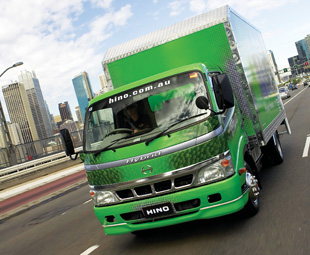The future and beyond

New technology is constantly hitting the market, and the transport industry is no different. FRITZ HELLBERG examines how this technology is benefiting local commercial transport.
The term “transport technology” covers a wide spectrum of disciplines and activities which would require a few days to do justice to the subject. I will limit myself to technology as it is applied to commercial vehicles and rigs that are in use, or likely to come into use, in the timber industry and, to some extent, technology applied in the management of these vehicles’ operation.
The key drivers that have spurred on technology over the last few decades have been the ever-increasing oil price and the looming spectre of diminishing fossil fuel reserves; the need to protect our environment; the need to drive down costs generally to become globally competitive; the stricter law enforcement of vehicle axle weights (or the need to become more payload efficient); and the need to achieve better vehicle utilisation by closer monitoring of vehicle activity.
ENGINES AND DRIVELINES
Progress is sometimes hard to track on a year-by-year basis, mainly because even though technological breakthroughs are achieved, they are often blurred by other happenings and, sometimes, political upheavals.
To get a longer-view perspective, it is perhaps worthwhile to take a step back in technical history and make some “then-and-now” comparisons. Specifically, I would like to repeat a recent comparison appearing in the German LastautoOmnibus magazine:
What has brought about this phenomenal difference? Simply put, turbo-charging, inter-cooling, common-rail fuel injection (electronic control), turbo-compounding, AdBlue, improved lubrication, driveline efficiencies and lower tyre rolling resistance.
While some of these changes, like higher compression and higher injection pressure, have forced the need for more meticulous maintenance, others – such as better engineering, low-sulphur fuel and improved lubrication technology – have also brought about extended oil-change intervals and substantial improvements in engine life.
A new phenomenon in transmissions is the Automated Mechanical Transmission (AMT) which has made its appearance in the last few years. This development has come about mainly because of an advancement
in electronics, particularly its reliability. Electronics can now accurately measure speed of gears in a transmission and exactly determine the point of speed synchronisation between to-be-engaged gears and successfully execute their engagement. This technology does away with the need for synchro rings, thus making it possible to strengthen gears by widening them, allowing higher torque throughputs. It is generally accepted that each additional gear reduction in a drive-train adds an extra 2.5% inefficiency (or reduced power loss). It is therefore a major advantage that high torque throughputs are now also possible in direct gears, doing away with the need for overdrive, and making the most often-used gear (top gear) also the most efficient one.
The advantage to operators of AMTs is that a less skilled driver can now achieve fuel consumption and vehicle productivity that were previously only achievable by skilled drivers.
The advent of high-torque motors has also led to the use of faster (numerically lower) diff ratios. Higher torque motors mean that good overall tractive effort produced at the drive-wheels can be maintained at much lower engine revs. If, therefore, a maximum speed of, say, 80 km/h is the aim, the average engine revs and thus fuel consumption are reduced by a faster diff ratio. Following the principle of reducing the number of gear reductions in a drive-train, going from a double-reduction drive-axle to a single-reduction one will further improve drive-train efficiency by approximately 2.5%.
FUEL AND LUBRICATION
One major drawback to diesel engine operating efficiency in South Africa has been the high sulphur content of our diesel fuel. High sulphur content not only leads to higher operating temperatures in engines, but also to higher undesirable exhaust emissions and engine lubricating oil contamination. South Africa’s legal limit for exhaust emissions currently stands at Euro 2 level, which is already substantially better than the previous Euro 1 limit, but lags well behind the Euro 5 limit which is currently in force in the EU, with Euro 6 to be introduced by 2012. So far there have been two schools of thought as to which method should be adopted to achieve the limits imposed by Euro 6 emission standards. Mercedes-Benz and some Japanese manufacturers have gone the AdBlue route, by which urea solution is injected into the exhaust system to neutralise toxic gases. MAN, Scania and the Americans have gone the Exhaust Gas Recirculation (EGR) route, which involves mechanical refinements within the engine to achieve the same objectives. The latter is the more expensive method and it seems that satisfactory results cannot be achieved beyond the Euro 5 standard. MAN for one has now reportedly abandoned research in this direction and has adopted the AdBlue route for its Euro 6 engines.
The following table and graph are an indication of how our current legislation compares to that of other countries. Some manufacturers have already started offering Euro 4 specification engines in South Africa despite the fact that low-sulphur fuel isn’t yet readily available.
Lubricating oils have likewise changed dramatically over the last decades. Whereas earlier oils largely used mineral
oil as a base, the trend is now towards synthetic oils. These oils are more stable
and can be designed to operate under very specific conditions. The advantages to operators are longer engine life and substantially longer oil-change periods. With Euro 4 specification fuel, oil-change intervals of up to 100 000 kms are possible as a result of the low level of oil contamination by the low level of sulphur content in the fuel.
ELECTRONICS
Modern commercial vehicles cannot be visualised without electronics. While early systems gave considerable problems in terms of frustrating downtime and expensive replacement of components, the reliability aspect has been addressed by manufacturers. The changes in engine performance, as detailed earlier, would not have been possible without electronics. This applies in particular to common-rail fuel injection systems where electronics now control the timing and quantity of fuel injection, even going as far as making several fuel injection occurrences per combustion cycle possible. Engine designers thus have much more freedom of choice and a better chance of meeting ever-tightening emission standards.
In addition to controlling gear changes in AMT transmissions, some niceties like cruise control, speed control via retarder control and electronically controlled foundation brakes have come into use; in addition, engines, gearboxes and other components “talk” to one another to optimise vehicle performance. Useful from a data exchange point of view is the CANBUS system which allows vehicle performance data to be exported to external information storage systems like notebooks to make vehicle and driver management more efficient.
BRAKING SYSTEMS AND RETARDERS
Probably the biggest change that has taken place in terms of foundation brakes is the move from drum brakes to disc brakes. The latter has made the maintenance of brakes a relatively simple operation and helped with the dissipation of heat that is inevitably generated when using foundation brakes. This has led to longer wheel-bearing life and greater vehicle safety.
The development of non-wearing retarder systems has seen an even bigger revolution over the last 40 years. In the late ‘60s and early ‘70s, some commercial vehicles were fitted with exhaust brakes that consisted of a butterfly valve in the exhaust system that effected retardation by closing off the exhaust. This system was reasonably efficient for naturally aspirated engines but lost its effectiveness for turbo-charged engines. A later, and much more efficient, system was the Jacobs brake that was initially developed for Cummins engines. This system created retardation by releasing compressed air in the engine to the atmosphere just prior to fuel injection taking place. In this way up to 75% of engine performance could be achieved as braking performance. This system has been refined over the years and is still in use today.
Wear-free retarders as we know them today first made their appearance as electro-magnetic retarders, such as the Telma retarders. These used the principle of metal discs cutting magnetic fields, thus creating retardation, and were fitted on the vehicle propshaft. Despite good efficiencies, they were heavy and expensive and created heat dissipation problems in some applications.
Hydraulic retarders are the latest development in this area. Although they are expensive, they develop retardation power exceeding the engine pulling power and are silent in operation. Heat dissipation is via the vehicle cooling system and engine heat is thus maintained even over long downhills.
Retarders are particularly useful in the timber industry, as trees are usually grown in higher altitudes. This results in a typical timber haulage operation being empty uphill and laden downhill. Apart from saving the use of foundation brakes for emergencies only, retarders allow much higher safe downhill speeds, thus increasing vehicle productivity.
SUSPENSIONS AND TYRES
Springs have evolved from multi-leaf springs, often with helper springs, to parabolic springs to air springs. All these types are currently still in use, either exclusively or in various combinations. Air springs in timber haulage have the disadvantage that the rubber bellows are prone to damage by twigs and stones in in-field haulage. However, they offer substantial weight savings and have buit-in lateral stabilisation which is an essential safety factor for loads with high centres of gravity such as raw timber.
Commercial vehicles have not yet followed bus and car suspension systems, which have in most cases gone independent all round. The main reason for this is that truck speeds are generally lower and trucks need to be easy to maintain.
Tyres have evolved from cross-ply tyres to radial-ply tyres, the latter now completely dominating the market. Radial-ply tyres offer much better cornering capability and lower rolling resistance. Tyre manufacturers have concentrated on improving tread life and rolling resistance with the result that it is not unusual to achieve 150 000 km on the original tyre tread.
Michelin has played around with what they call the “Tweel”. This is a combination wheel/tyre manufactured from synthetic material where the load deflection is taken up by “spokes” that deform. Although rolling resistance is reduced with this invention, noise is still a problem.
CHASSIS AND TRAILER MATERIALS
With increased law enforcement, the emphasis being on axle loading, there is also an increased requirement to maximise payloads while still staying inside the legal GCM of 56 000 kg. Tare mass reductions have been achieved by using materials that have a higher strength-to-mass ratio and/or by using lighter wheel and tyre equipment.
Materials that fall into this category are aluminium and domex steel. Of course, rig configuration also plays a significant part with rigid truck/drawbar trailer combinations able to offer a payload to tare mass ratio of 2.5:1.
To sum up, the following table shows the potential improvements in productivity that may be achieved, using the technologies mentioned above:
VEHICLE TRACKING AND PERFORMANCE PREDICTION
In South Africa, vehicle tracking started off as a means to trace a vehicle after it was hijacked. Since then it has become a vehicle  management tool that can be used in a variety of applications such as managing salespeople’s time and calls or, as in the timber industry, managing vehicle standing time. Vehicle standing time is one of the biggest profit thieves in such an application. In timber haulage, standing time can be made up of waiting to load, loading, waiting to offload, offloading and shift change. In a sugar cane haulage application we were involved in recently, the difference between standing time per trip of 1¾ hours and two hours per trip meant an extra vehicle was needed to haul the required tonnage. Including depreciation and interest, licence fees, insurance and extra drivers, this made a difference of R3.00 per ton of sugar cane hauled.
management tool that can be used in a variety of applications such as managing salespeople’s time and calls or, as in the timber industry, managing vehicle standing time. Vehicle standing time is one of the biggest profit thieves in such an application. In timber haulage, standing time can be made up of waiting to load, loading, waiting to offload, offloading and shift change. In a sugar cane haulage application we were involved in recently, the difference between standing time per trip of 1¾ hours and two hours per trip meant an extra vehicle was needed to haul the required tonnage. Including depreciation and interest, licence fees, insurance and extra drivers, this made a difference of R3.00 per ton of sugar cane hauled.
A further development from vehicle tracking is that the GPS route trace of the rig can now be downloaded and analysed. For example, our TransSolve vehicle simulation program can benchmark fuel consumption if the loading and offloading details are known. The benchmark fuel consumption can then be calculated for each trip and compared to the actual fuel consumption. In a recent study, we followed the movements of eight vehicles, out of a prominent South African fleet, for a period of five days and simulated their trips. The result was that, of the
50 odd trips these vehicles did in that time, only about 10 came within a reasonable reach of our benchmark fuel consumption. This is quite a serious situation and we are still investigating the reason for this discrepancy.
WHAT OF THE FUTURE?
The big talk in motoring circles these days is hybrid, electric or biofuel. The first two options have a very distinct application in stop-start-type operations, such as buses and retail in-town deliveries, and the latter is still mired in controversy about the source of such fuel being taken away from hungry mouths. There is now also encouraging research in the USA in the development of fuel from self-procreating algae.
If the rate of development for diesel engines over the next 40 years is maintained at even 50% of what it was over the last 40 years, we will end up with, say, a 15-l engine developing 633 kW of power, 5 700 Nm of torque, using 32 l/100km of fuel and producing a payload productivity of 75. This is not idle conjecture as researchers at Ilmor, a Mercedes-Benz-owned company in the UK, have already achieved a power to volume ratio of 145 kW per litre of engine displacement with a revolutionary six-stroke engine. This compares with a current best ratio of 30.5 kW per litre. This engine utilises two pistons, working in the well-known four-cycle principle, exhausting into a higher-volume single cylinder where an additional working phase is achieved.
Judging by this development, the diesel engine still has tremendous potential.
Published by
Focus on Transport
focusmagsa




 Big news from FOCUS on Transport + Logist
Big news from FOCUS on Transport + Logist


 !
Starting 1 April, every
!
Starting 1 April, every


 FUSO: Driving the Future of Mobile Healthc
FUSO: Driving the Future of Mobile Healthc



 A brand
A brand




 Wondering about the maximum legal load for a
Wondering about the maximum legal load for a 
 The MAN hTGX powered by a hydrogen combus
The MAN hTGX powered by a hydrogen combus

 Exciting News for South African Operators
Exciting News for South African Operators


